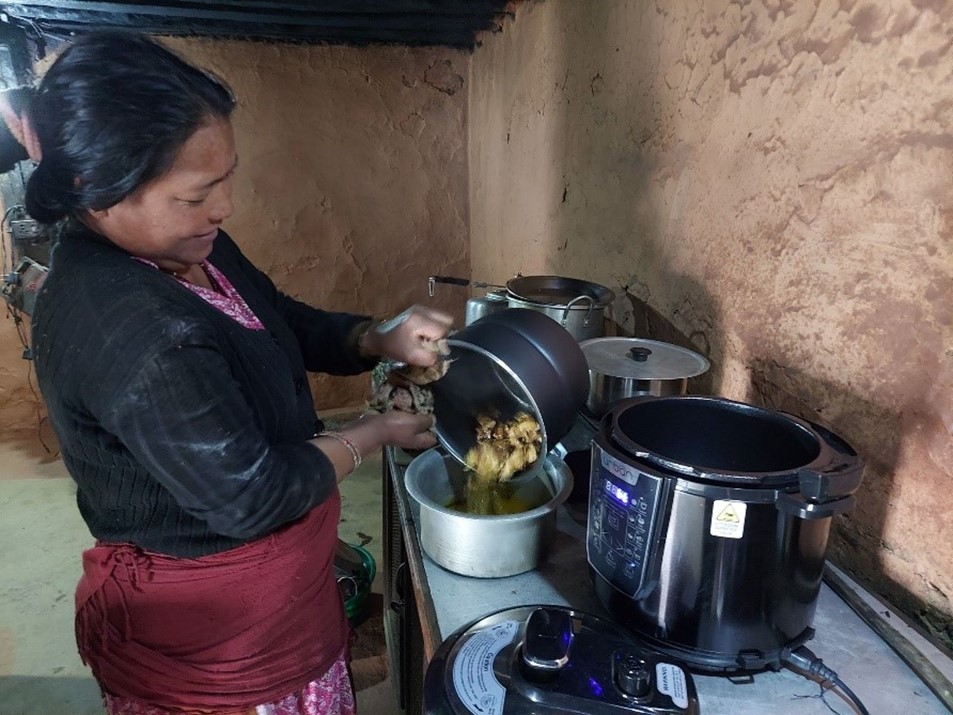
- Date
- 24th January 2023
- Categories
By Richard Sieff (MECS) and Biraj Gautam (PEEDA)
Introduction: why narratives matter
Stories and narratives can have a major impact on how new technologies and services are perceived and, consequently whether they are adopted. This impact means that adoption cannot be predicted solely from the characteristics and benefits of the technology/service itself as examples from the health and IT sectors highlight. Narrative framing is therefore a key piece of the MECS ‘jigsaw’ country-level theory of change, falling mainly under the core area of consumer awareness (Figure 1) . The shaping of narratives is of particular importance in Nepal, where prevalent, inaccurate framing threatens to undermine clear opportunities for scale-up unless addressed.

Primary mode, not only mode, of cooking
The potential for scaled eCooking uptake beyond the 6% of Nepalis already using electricity as their primary cooking fuel is clear . Nepal was ranked 2nd on the MECS Global Market Assessment for scale up viability – potential reaffirmed by a recent MECS Nepal eCooking Market Assessment which found the current and near future opportunities for eCooking to be highly promising due to increasing domestic hydropower production, rising consumer demand, and a supportive national policy framework. Greater uptake of eCooking can lead to large falls in cooking with fossil fuels and biomass, reducing greenhouse gas emissions, contributing to national climate change targets and offering major health, social, economic, gender related, and environmental benefits. In Nepal eCooking also supports greater utilization of increasing domestic renewable energy generation and reduced reliance on imported LPG, improving the country’s energy security and trade deficit.
Given the multi-faceted benefits of transitioning to electric cooking, it comes as a surprise to see headlines such as “Why are Nepalis not keen on electric cooking?” in the national press. The answer provided, “outages and power tripping”, symptomatic of a prominent, yet misleading, narrative that transitioning to electric cooking means a 100% transition. This narrative is holding people back from adopting eCooking as people understandably fear a full transition is not possible due to reliability issues with the electricity supply. While significant improvements are required to improve electricity transmission and distribution infrastructure, it must be realized that transitioning to electric cooking does not mean a 100% shift and that major benefits are currently very much viable from a part-transition that needs to be far more actively promoted and encouraged.
The inaccuracy of this 100% transition narrative is easily demonstrated by the Government of Nepal’s eCooking policy. Usage targets set by Nepal’s Nationally Determined Contributions (NDCs) are for 25% of people to adopt eCooking as a primary mode of cooking by 2030 – meaning a minimum of 50.1% of electric cooking, not 100%. A 50.1% target is already currently feasible in many urban areas and was even demonstrated in rural areas by a recent MECS pilot study. Although ‘Primary mode of cooking’ offers a range of scenarios (i.e., 50.1% to 100% of household cooking), the focus on the higher end has been counterproductive, discouraging potential eCooking consumers from a wholly viable part-transition offering a range of significant benefits.

Positive narrative and part-transitions – the many benefits
Positive and more accurate framing should instead focus on eCooking as part of an increasingly clean ‘fuel stack’ and highlight the current, significant benefits of a part-transition to eCooking, which can steadily be increased over time. Current cooking fuel costs for energy-efficient electric appliances are lower compared to devices using LPG or purchased firewood, with new highly efficient appliances such as electric pressure cookers (EPCs) particularly cheap, offering households 60% savings on cooking fuel costs (Figure 3). A study by the People, Energy, and Environment Development Association (PEEDA) noted that replacing two firewood cooking events with eCooking reduced household firewood consumption by 50-55%, demonstrating how a part-transition can reduce greenhouse gas emissions and make a significant contribution to Nepal’s NDC targets to climate change.
Furthermore, where positive narratives and part-transitions have been encouraged, the impact has been considerable as shown by the rapid, significant and sustained eCooking uptake in four recent MECS pilot studies in Nepal (Figure 4). Funded under the Electric Cooking (ECO) challenge fund, the studies demonstrated not only the compatibility of efficient electric cooking appliances with local menus, but that people from various cultural and socio-economic groups in both grid and off-grid locations were willing to use and pay for efficient electric cooking appliances. User experiences of eCooking were also overwhelmingly positive, with ease of use, convenience, taste, time and cost savings especially praised.


Conclusion and call for action
The sooner the narrative shifts away from 100% eCooking and embraces the actual Government of Nepal’s target of electricity as a primary mode of cooking, the sooner Nepal can reap the multiple cost saving, health, and environmental benefits of an already viable part-transition to eCooking. These benefits can significantly contribute to Nepal’s energy security, trade deficit, and climate change targets and will only increase over time as improved electricity supply reliability enables smoother and fuller transitions to electric cooking. To support this part transition, this blog calls for key stakeholders such as policy makers and media outlets to be far more dynamic in promoting a positive and more accurate narrative, which focuses on the current and significant benefits of a part-transition to eCooking as part of an increasingly clean cooking fuel stack.
Featured image. Positive narratives and part-transitions encouraged during the ECO pilot studies resulted in significant and sustained eCooking uptake and positive user experiences (Image credit: PEEDA, 2021).
1.The MECS country level theory of change is a jigsaw of pieces, where all the pieces of a (location specific) puzzle need to be in place to enable scaled eCooking uptake. Jigsaws have three core areas (enabling environment, supply chain, consumer needs) comprised of a number of constituent pieces. Examples of pieces where narrative framing intersects include: ‘existing beliefs’, ‘consumer confidence’, ‘aspirations’, and ‘media promotion’.
2.Government of Nepal Ministry of Forests and Environment (2021)